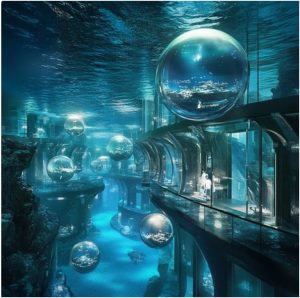Feb. 19, 2025
Technology Discussion: Let’s Colonize Earth’s Oceans!
Reposted from 11/13/2019

Domed underwater cities. Great metropolises floating on the surface of the ocean. Could this be what the future holds?
Roughly three-quarters of the earth’s surface is covered with water, leaving less than a quarter available for every human being on the planet. As populations continue to explode across our beautiful planet, perhaps it’s time to begin planning a migration to the earth’s oceans for at least some portion of humanity.

As rapid progress is being made toward sending human beings to Mars, towards the eventual colonization of our sister planet Mars, it seems only fitting that we consider colonizing our own planet as well.
While doing research for this blog post, I came across three different approaches to living on or in the ocean. But first, a brief history lesson on the history of undersea habitats.
“SEALAB III, launched in 1969, was the U.S. Navy’s last undersea habitat built.
OAR/National Undersea Research Program (NURP); U.S. Navy
“While NASA was working to put a man on the moon, we also started thinking more about the possibility of colonizing on our own planet. It might even be a good test-drive to find out how well we could live on the moon, plus we could test out living in an isolated environment and conduct research experiments.
“The U.S. government has been involved in several underwater habitats. First the U.S. Navy built SEALAB I, an experimental underwater habitat, in 1964 and sunk it 192 feet (58 meters) below sea level. SEALAB II and III followed. Tektite, built by General Electric and funded by NASA, the U.S. Navy and the U.S. Department of the Interior, was another research facility in the late 1960s.
“There were totally private ventures, too. Famous marine explorer Jacques Cousteau built the Conshelf habitats in the mid-1960s (the deepest of which was about 336 feet or 102 meters). It didn’t take long for innovators to think about longer-term living, though. At the 1964 World’s Fair in New York, the Futurama II exhibit presented by General Motors included an undersea hotel. In 1971, a group of British investors created models promoting an entire city underwater, which would have been built in the Black Sea and called Pilkington Sea City.
“There are still underwater research facilities, and a few underwater hotels, but no cities. Why not? One big issue is decompression sickness, or “the bends,” a potentially fatal condition related to the fact that water exerts twice as much pressure on our bodies as air. Maintaining the right atmosphere, as well as the logistics of providing supplies, is complicated and expensive. That’s probably why a night in the Jules’ Undersea Lodge in Key Largo, Florida (a remodeled underwater research habitat built in the early 1970s) costs upwards of $500 and it’s only about 30 feet below.”
https://home.howstuffworks.com/10-future-home-innovations-that-failed1.htm
So the idea of colonizing the earth’s oceans is not a new one. People have speculated about it, wrote about it, and some have lived it, albeit never more than a few weeks or months at a time. Advances in technology over the past sixty years since it was first attempted, along with concerns over a growing population, fear over global warming and rising oceans, and a host of other issues have once again ignited not just discussions, but actual progress toward making living on or under the ocean a realty. It seems human colonization of the earth’s oceans has already begun.
So, here are three approaches toward colonizing the world’s oceans that I’ve uncovered in my research. One can happen today, while the other two require some new technological advances.
Approach #1-Build Floating Cities
Located mostly in shallow-waters near land, floating cities would be capable of seemingly endless expansion, and offer a tempting alternative to land-based living, where locations can be found that are safe for locating a floating city. Clearly, such a city would be extraordinarily vulnerable to hurricanes and tsunamis, so they would have to be located in carefully selected locations across the planet.
“The world’s first floating nation designed to ‘liberate humanity from politicians’ will appear in the Pacific Ocean by 2020.
The radical plans, bankrolled by PayPal founder Peter Thiel, will see a floating nation built in the Pacific Ocean
Hotels, homes, offices and restaurants, and more will be built by 2020 by the nonprofit Seasteading Institute
In January the firm made a deal with French Polynesia to set up an experimental nation off its coast
Joe Quirk, president of the Seasteading Institute, said he wants to see ‘thousands’ of floating cities by 2050…”
https://www.dailymail.co.uk/sciencetech/article-5077575/The-world-s-floating-city-set-2020-build.html
Approach #2-Build Underwater Cities
Unlike the floating cities, underwater cities can exist in shallow waters and in deep water, which covers the majority of the earth’s surface. There are, of course, a wide variety of obstacles to overcome in order for human beings to not only survive, but thrive, in underwater cities. Below are just a few:
The intense pressures found in deep waters, which can crush a submarine like an aluminum beer can. Anything greater than one atmosphere of pressure can result in serious detrimental affects on the human body over time.
Oxygen. Human beings have lungs, not gills, so air has to be pumped in or generated locally in order to sustain an underwater human colony.
Temperature. Deep water is cold, very cold.
Living in a deep water colony means that a complex balancing-act of oxygen, carbon dioxide, pressure, and temperature means that an underwater colony, like a spaceship, must have a complex and reliable life-support system.
There is one serious effort already underway in Japan, and its name is OCEAN SPIRAL, a Deep Sea Future City Concept. Incredibly, it is believed Ocean Spiral City will be ready for its first 5,000 residents by 2030!
Ocean Spiral City:
“Underwater city costing $26 BILLION to be ready for human residents in 12 years
AN UNDERWATER city costing billions of dollars will be ready for its first human inhabitants in just 12 years, it has been reported.
A deep-sea future city concept: Ocean Spiral
The Ocean Spiral concept for a deep-sea city of the future aims to harness the power of the deep sea in order to renew the earth. Academic advisors from the University of Tokyo have helped on the project plans.
Architects in Tokyo first unveiled their ambitious plan to create Ocean Spiral City in 2014, stating it will be the first self-sufficient city in the world.
Engineering firm Shimizu Corporation said the environmentally-friendly metropolis will use the available ocean resources to run….”
https://www.dailystar.co.uk/news/weird-news/underwater-city-ocean-spiral-spacex-16856287
Link to the Shimizu Corporation’s webpage for the Ocean Spiral City:
https://www.shimz.co.jp/en/topics/dream/content01/
It’s incredible to imagine that within twelve years, there will be an underwater city capable of hosting up to five-thousand inhabitants!
Approach #3-A Human Being built to Thrive in the Ocean
Certain to be the most controversial of the three approaches, surely we must consider what will surely one day come to pass, the genetic manipulation of human DNA to enable them to breath in the water, and to withstand the great pressure and cold of the ocean.
In the science-fiction film The Titan, Sam Worthington plays a military family-man who takes part in a ground-breaking experiment of genetic evolution and space exploration, an experiment designed to adapt a human being to be genetically compatible with the atmosphere and environment on Saturn’s moon, Titan.
For the first time in human history we have the capability to manipulate our own DNA. Is it really so difficult to believe that someone, somewhere on planet earth, in the near future, will modify human germline cells to create a human being no longer in need of a pressure suit or submersible while exploring or living in the ocean depths?
Is it so difficult to imagine the creation of a new species of human being, homo-aquatic (remember it was me who first used this term!), who is at home on land or in the ocean depths?
For now, this creature exists only in the imagination, but remember that today’s science-fiction is often tomorrow’s science fact.
In summary, it seems to be a certainty that one day soon human beings will be colonizing the earth’s oceans, opening up a significant amount of real estate for the nation, or nations, bold enough to invest in tomorrow.
Jeff W Horton strives to write fun, exciting, revealing, and widely entertaining fiction with a slight Christian flavor.
You can find all of Jeff’s published novels here: Works by Jeff W. Horton | The Horton Library
Follow Jeff:
• Blog: Subscribe to his blog! https://www.hortonlibrary.com/the-horton-post/
Tell your friends about it!
• Linked-In: https://www.linkedin.com/in/jeff-w-horton-a8378674/
• Follow Jeff on X: https://x.com/AuthorJWHorton
You might also want to explore Jeff’s website: at www.hortonlibrary.com, or visit him on the
Amazon’s Author Website for Jeff: https://www.amazon.com/stores/Jeff-W.-Horton/author/B004NK5MJC?ref=ap_rdr&isDramIntegrated=true&shoppingPortalEnabled=true
Barnes & Noble’s Website: https://tinyurl.com/1emwpg16